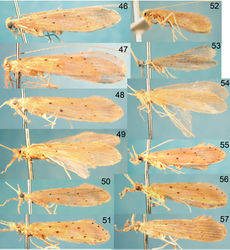Oecetis acciptrina
| Notice: | This page is derived from the original publication listed below, whose author(s) should always be credited. Further contributors may edit and improve the content of this page and, consequently, need to be credited as well (see page history). Any assessment of factual correctness requires a careful review of the original article as well as of subsequent contributions.
If you are uncertain whether your planned contribution is correct or not, we suggest that you use the associated discussion page instead of editing the page directly. This page should be cited as follows (rationale):
Citation formats to copy and paste
BibTeX: @article{Blahnik2014ZooKeys376, RIS/ Endnote: TY - JOUR Wikipedia/ Citizendium: <ref name="Blahnik2014ZooKeys376">{{Citation See also the citation download page at the journal. |
Ordo: Trichoptera
Familia: Leptoceridae
Genus: Oecetis
Name
Oecetis acciptrina Blahnik & Holzenthal, 2014 sp. n. – Wikispecies link – ZooBank link – Pensoft Profile
Diagnosis
This species is readily identified by its small size and by the distinctive hooked apex of the phallobase, which is V-shaped in caudal view. In no other species that is similar in size, and within the geographic range of this species, is the ventral lobe of the inferior appendage so indistinctly demarcated from the dorsal lobe. Otherwise, this species is very similar in size and appearance to Oecetis constricta sp. n., or Oecetis mexicana sp. n., although it is slightly darker in color and with somewhat smaller forewing spots. Species sympatric with this species and also having the apex of the phallobase V-shaped in caudal view (Oecetis metlacensis, Oecetis uncata sp. n., and Oecetis angularis sp. n.) are much larger in size. The habitus figure for this species (Fig. 52) is of a female, included because the pinned male (holotype) was partially denuded of setae. The female is smaller than the male and slightly darker, but similarly marked.
Adult
Forewing length: male (5.5 mm), female (5.3). Color yellowish-brown (darker than Oecetis mexicana sp. n.). Antennae whitish, with indistinct, narrow annulations at intersection of antennomeres. Forewing spots present, but relatively small and indistinct, not greatly contrasting with overall color of wing; spots at base of discal and thyridial cells, and base of fork V largest; veins of forewing chord lightly pigmented, relatively narrowly and evenly spaced, spots at opposite ends of chord evident; apical spots, at apices of major veins, present, but indistinct. Setae along veins in apical part of forewing semi-prostrate, somewhat laterally diverging, not conspicuously denser than on wing membrane. Fringe of setae along costal margin of forewing moderately dense, elongate, semi-erect.
Male genitalia
Segment IX very short, with elongate setae along posterolateral margin. Tergum X with narrow, deflexed mesal lobe, apex of lobe inflated (lobulate), with small sensilla; lobe continuous basoventrally with short, paired lateral membranous projections. Preanal appendage moderately elongate, length about 3-4 times maximum width, simple in structure, apical setae elongate. Inferior appendage with prominent, but short, broadly rounded dorsal lobe and weakly projecting ventral lobe; ventral lobe either demarcated from dorsal lobe by broadly rounded invagination or forming weakly protruding, obtusely angled projection; posterior margin of ventral lobe, as viewed ventrally (Fig. 1E), with mesal bend rounded, not angular, apical projections of paired appendages not strongly diverging; basomesal projection of appendage very weakly projecting, with short, stiff setae; dorsal lobe with stout, mesally-curved setae on dorsal margin and stout, ventrally-curved setae on mesal surface. Phallobase short, tubular basally, ventral apex abruptly and strongly down-curved at about apical third, nearly at right angle with base, apex acute; ventral apex, as viewed caudally, V-shaped (distinctly keeled) (Fig. 1C). Phallotremal sclerite prominent, basally forming short tubular collar, ventral margin projecting, apex acute; asymmetrical lateral sclerite absent.
Holotype
Male (pinned), ECUADOR: Pichincha: Santo Domingo (47 km S), Río Palenque Biol. Station, el 750 m, 29.vii.1976, J. Cohen (NMNH) (UMSP000208335).
Paratypes
COSTA RICA: Puntarenas: Reserva Biologica Carara, Quebrada Bonita, 9°46.500'N, 84°36.300'W, el 35 m, 18–20.v.1990, Holzenthal & Blahnik, 1 male (alcohol) (UMSP); PANAMA: Canal Zone: Barro Colorado Island, 12.iii.1967, M. E. Irwin, 5 males, 6 females (alcohol) (NMNH); Chiriqui: Guadalupe Arriba, 8°52.433'N, 82°33.217'W, 6–12.vi.1984, H. Wolda, 1 male (alcohol) (NMNH); ECUADOR: Pichincha: same data as holotype, 2 females (pinned) (NMNH).
Etymology
This species is named Oecetis acciptrina after the Latin word accipter, a hawk, and referring to the phallobase in this species, which has its ventral apex strongly bent, somewhat resembling a hawk’s bill.
Original Description
- Blahnik, R; Holzenthal, R; 2014: Review and redescription of species in the Oecetis avara group, with the description of 15 new species (Trichoptera, Leptoceridae) ZooKeys, 376: 1-83. doi
Images
|

